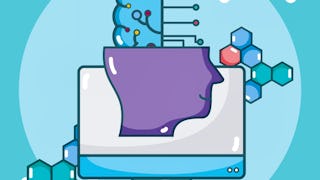In this course, we will build on our knowledge of basic models and explore advanced AI techniques. We’ll start with a deep dive into neural networks, building our knowledge from the ground up by examining the structure and properties. Then we’ll code some simple neural network models and learn to avoid overfitting, regularization, and other hyper-parameter tricks. After a project predicting likelihood of heart disease given health characteristics, we’ll move to random forests. We’ll describe the differences between the two techniques and explore their differing origins in detail. Finally, we’ll complete a project predicting similarity between health patients using random forests.

Gain next-level skills with Coursera Plus for $199 (regularly $399). Save now.

Neural Networks and Random Forests
This course is part of AI for Scientific Research Specialization


Instructors: Rajvir Dua
2,052 already enrolled
Included with
Recommended experience
Skills you'll gain
Details to know

Add to your LinkedIn profile
3 assignments
See how employees at top companies are mastering in-demand skills

Build your subject-matter expertise
- Learn new concepts from industry experts
- Gain a foundational understanding of a subject or tool
- Develop job-relevant skills with hands-on projects
- Earn a shareable career certificate

There are 4 modules in this course
In this module, we'll go through neural networks and how to use them in Python. We'll start by describing what a neural network is and how to construct one by combining a sequence of linear models. Then, we'll talk about converge of neural networks in the hopes of minimizing a loss function. Finally, we'll learn how to code a neural network in Python.
What's included
5 videos3 readings2 assignments1 discussion prompt
In this module, we'll take a more detailed look into neural network and the considerations we should be having when using them. We'll start by adding layers to our 2-layer network, exploring the different options and their effects. Then, we'll explore some more advanced Python libraries for neural networks in TensorFlow and Keras. Finally, we'll discuss the implications to science and how to apply the models in the space.
What's included
3 videos5 readings1 assignment1 ungraded lab
In this module, we'll build up our knowledge of random forests and their uses in science. We'll start by exploring decision trees and how they operate as models in isolation. Next, we'll look at the impact of combining decision trees to create random forests. From here, we'll talk about the similarities and differences between regression and classification with random forests before concluding with a final project predicting species from lineage.
What's included
2 videos2 readings1 programming assignment1 discussion prompt
In this final project, we'll be comparing a suite of models to find the one that best predicts sepal width.
What's included
1 programming assignment
Earn a career certificate
Add this credential to your LinkedIn profile, resume, or CV. Share it on social media and in your performance review.
Offered by
Explore more from Machine Learning
 Status: Free Trial
Status: Free TrialJohns Hopkins University
 Status: Free Trial
Status: Free TrialDartmouth College
 Status: Free Trial
Status: Free TrialUniversity of Illinois Urbana-Champaign
Why people choose Coursera for their career





Open new doors with Coursera Plus
Unlimited access to 10,000+ world-class courses, hands-on projects, and job-ready certificate programs - all included in your subscription
Advance your career with an online degree
Earn a degree from world-class universities - 100% online
Join over 3,400 global companies that choose Coursera for Business
Upskill your employees to excel in the digital economy
Frequently asked questions
To access the course materials, assignments and to earn a Certificate, you will need to purchase the Certificate experience when you enroll in a course. You can try a Free Trial instead, or apply for Financial Aid. The course may offer 'Full Course, No Certificate' instead. This option lets you see all course materials, submit required assessments, and get a final grade. This also means that you will not be able to purchase a Certificate experience.
When you enroll in the course, you get access to all of the courses in the Specialization, and you earn a certificate when you complete the work. Your electronic Certificate will be added to your Accomplishments page - from there, you can print your Certificate or add it to your LinkedIn profile.
Yes. In select learning programs, you can apply for financial aid or a scholarship if you can’t afford the enrollment fee. If fin aid or scholarship is available for your learning program selection, you’ll find a link to apply on the description page.
More questions
Financial aid available,


